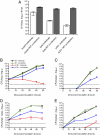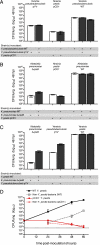Pulmonary infection by Yersinia pestis rapidly establishes a permissive environment for microbial proliferation
- PMID: 22308352
- PMCID: PMC3286930
- DOI: 10.1073/pnas.1112729109
Pulmonary infection by Yersinia pestis rapidly establishes a permissive environment for microbial proliferation
Abstract
Disease progression of primary pneumonic plague is biphasic, consisting of a preinflammatory and a proinflammatory phase. During the long preinflammatory phase, bacteria replicate to high levels, seemingly uninhibited by normal pulmonary defenses. In a coinfection model of pneumonic plague, it appears that Yersinia pestis quickly creates a localized, dominant anti-inflammatory state that allows for the survival and rapid growth of both itself and normally avirulent organisms. Yersinia pseudotuberculosis, the relatively recent progenitor of Y. pestis, shows no similar trans-complementation effect, which is unprecedented among other respiratory pathogens. We demonstrate that the effectors secreted by the Ysc type III secretion system are necessary but not sufficient to mediate this apparent immunosuppression. Even an unbiased negative selection screen using a vast pool of Y. pestis mutants revealed no selection against any known virulence genes, demonstrating the transformation of the lung from a highly restrictive to a generally permissive environment during the preinflammatory phase of pneumonic plague.
Conflict of interest statement
The authors declare no conflict of interest.
Figures



Similar articles
-
Yersinia pestis Exploits Early Activation of MyD88 for Growth in the Lungs during Pneumonic Plague.Infect Immun. 2019 Mar 25;87(4):e00757-18. doi: 10.1128/IAI.00757-18. Print 2019 Apr. Infect Immun. 2019. PMID: 30642901 Free PMC article.
-
Tn-Seq Analysis Identifies Genes Important for Yersinia pestis Adherence during Primary Pneumonic Plague.mSphere. 2020 Aug 5;5(4):e00715-20. doi: 10.1128/mSphere.00715-20. mSphere. 2020. PMID: 32759339 Free PMC article.
-
Yersinia pestis endowed with increased cytotoxicity is avirulent in a bubonic plague model and induces rapid protection against pneumonic plague.PLoS One. 2009 Jun 16;4(6):e5938. doi: 10.1371/journal.pone.0005938. PLoS One. 2009. PMID: 19529770 Free PMC article.
-
Pneumonic Plague: The Darker Side of Yersinia pestis.Trends Microbiol. 2016 Mar;24(3):190-197. doi: 10.1016/j.tim.2015.11.008. Epub 2015 Dec 14. Trends Microbiol. 2016. PMID: 26698952 Review.
-
[Modern concepts on the relationship between the agents causing plague and pseudotuberculosis].Mol Gen Mikrobiol Virusol. 2002;(1):3-7. Mol Gen Mikrobiol Virusol. 2002. PMID: 11904922 Review. Russian.
Cited by
-
Yersinia pestis Exploits Early Activation of MyD88 for Growth in the Lungs during Pneumonic Plague.Infect Immun. 2019 Mar 25;87(4):e00757-18. doi: 10.1128/IAI.00757-18. Print 2019 Apr. Infect Immun. 2019. PMID: 30642901 Free PMC article.
-
Competitive Cell Death Interactions in Pulmonary Infection: Host Modulation Versus Pathogen Manipulation.Front Immunol. 2020 May 19;11:814. doi: 10.3389/fimmu.2020.00814. eCollection 2020. Front Immunol. 2020. PMID: 32508813 Free PMC article. Review.
-
Plague vaccines: current developments and future perspectives.Emerg Microbes Infect. 2012 Nov;1(11):e36. doi: 10.1038/emi.2012.34. Epub 2012 Nov 7. Emerg Microbes Infect. 2012. PMID: 26038406 Free PMC article. Review.
-
Comprehensive Laboratory Evaluation of a Lateral Flow Assay for the Detection of Yersinia pestis.Health Secur. 2019 Nov/Dec;17(6):439-453. doi: 10.1089/hs.2019.0094. Health Secur. 2019. PMID: 31859568 Free PMC article.
-
Inactivation of Peroxiredoxin 6 by the Pla Protease of Yersinia pestis.Infect Immun. 2015 Nov 9;84(1):365-74. doi: 10.1128/IAI.01168-15. Print 2016 Jan. Infect Immun. 2015. PMID: 26553463 Free PMC article.
References
-
- Agar SL, et al. Characterization of a mouse model of plague after aerosolization of Yersinia pestis CO92. Microbiology. 2008;154(Pt 7):1939–1948. - PubMed
-
- Montminy SW, et al. Virulence factors of Yersinia pestis are overcome by a strong lipopolysaccharide response. Nat Immunol. 2006;7:1066–1073. - PubMed
Publication types
MeSH terms
Grants and funding
LinkOut - more resources
Full Text Sources
Other Literature Sources

